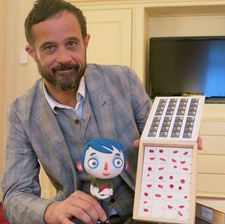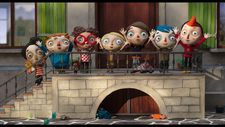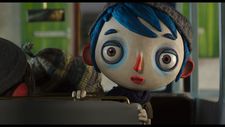 |
| The eyes have it: Claude Barras with Courgette - and his box of tricks. Photo: Richard Mowe |
From the moment it bowed in the Cannes Directors’ Fortnight last year until now, a modest budget animation film by an unknown director has been fêted and acclaimed at Festivals all over the world with, notably, an Oscar nomination and a César win in France. Claude Barras, the director of My Life as a Courgette (or Zucchini in the States) has barely had time to draw breath. He pauses to reflect on a phenomenal few months, his admiration for Nick Park and the Aardman Studios, his collaboration with French director Céline Sciamma, and why simplicity is the key to his work.
Richard Mowe: You have been living with My Life As A Courgette for quite some time - has it been a bit of an endurance test ?
Claude Barras: Yes, that’s right - it was four years to make the film but it was another ten years previously that I read the book and started work on the development of the script and the whole project. In between doing several short films I kept working on it - and then eventually I met the right producers and the film got off the starting blocks.
RM: Did Gilles Paris, the author of the original, give you any ideas - or any thoughts about how he thought the film might be?
CB: What I liked about the book was that despite all the misfortune among these children it was love and kindness that triumphed in the end and Gilles wanted us to stress that. I thought that it was a film that would appeal to children as well as adults. The book is made up of lots of little stories, and there are many characters which makes it complicated for a film script. You have to chose who to include and who to leave out. We had to have enough to make a diverse group, but not too many because we had a restricted budget. Each character has his part in the film, and that was the main challenge of the script.
RM: At what point did your co-writer Céline Sciamma come on board, and did you already know her work and her films?
CB: It was the idea of my producer in Geneva. I had written the script and was quite pleased with what I had done. But I am not a script-writer as such. The producer said there were some good things in it, but that there was still work to be done on the script. He said perhaps you could work with Céline - it was just at the moment when her film Tomboy was coming out. I had seen it in the cinema and thought it was great, so I was perfectly happy with the idea of working with her. Céline had a look at what we had written so far, and she said yes more or less immediately. She was very keen on animation and had dreamt of working in animation so it was a good encounter.
RM: How did the two of you work together?
CB: We did one or two days of encounters where we discussed the film and I gave her the version that we had done up to that point. She said that there things that worked really well and she ended up keeping about a quarter of what we had done. She rewrote the rest by taking things from the book and so on. We had three exchanges backwards and forwards and then locked down a final version. The book wasn’t really aimed at children but I think we opened it up for them as well. It was really quite a simple and minimalist approach. I would love to work with her again.
 |
| "The book is made up of lots of little stories, and there are many characters which makes it complicated for a film script.” - Claude Barras Photo: UniFrance |
RM: Have you any idea where her fascination for animation came from?
CB: Céline is someone who has a great sense of curiosity. She has a very wide view of cinema - and animation was something she wanted to try. She has a real gift for speaking about childhood and adolescence, and coming-of-age stories. You can see this in all her films.
RM: And from where did your passion for animation derive?
CB: The first thing that I remember being touched by as a child was the TV series of Heidi made in the Seventies by a Japanese Isao Takahata - and there is something of that series in Courgette in the sense of the simplicity of the characters and the melodramatic and realistic side of the story. For the characters’ voices we decided to choose non-professional child actors who were as close to the characters as possible in terms of their energy and nature.
RM: Do you consider yourself as a Swiss director?
CB: Yes, but above all European, I would say. I think that European cinema has a particular sensibility and animation too. Because our budgets are modest and in the region of 10 million euros we have a lot of liberty in terms of the aesthetics of the film - because we have to do things simply to keep within the financial constraints. It makes the atmosphere very creative but also we have to keep the brakes on to stay within budget which marks the main difference with American animation.
RM: Is there a strong tradition of animation in Switzerland?
CB: Yes there is - but it is quite particular because there is no industry as such, no features and no TV series. There is plenty of subsidy for short animation films to encourage people to make them and there are animation schools in Lucerne and Lausanne. We are somewhere between French and German cultures. I went to a school of illustration in Lyon where I had my initiation in animation and made some useful contacts.
RM: Did you begin your interest in drawing as a child?
CB: That’s right … my parents have a small vineyard and are used to working on the land and my father was a Sunday painter, as you say. He taught me to draw and basically I have never stopped drawing since then.
RM: Now your film seems to have taken on a life of its own with all the prizes and Festival attention - what is your reaction?
CB: It’s all gone a bit mad, especially for my first feature. At the same time there was a lot of work over a long period of time with quite a big team therefore it is satisfying for us all to see that it appears to work. Animation takes such a long time. You work quite quickly on each part but the fabrication of it takes a long time, even on the big American productions with all their resources it takes four or five years to come to fruition. Everyone who works on animation dreams of the world of the characters and lives with them for the period of the ‘fabrication.’
RM: Most of the characters have wide-open eyes - what was the thinking behind that?
CB: Strangely I like the films of auteurs like Ken Loach or the Dardenne Brothers which deal with social topics. In their films they deal with emotions and have close-ups of the characters faces and eyes and I wanted to follow that here. The film’s main character is a nine-year-old, nicknamed ‘Courgette’ by his mother. When she dies he moves to an orphanage where, at first, he is bullied. He is also consumed by guilt, believing he is in some way responsible for his mother’s death. 60% of the animation is around the eyes and the idea was to have something quite simple in which we could change the emotions with the turn of the lip here or a frown there. [At this point in the interview Barras dips into his box of tricks on the table between us to show how his model of Courgette can be changed in an instant from happy to sad].
RM: You have won a César for best animation and were nominated for the Oscars as Switzerland’s representative in the animation category. How did you cope with all the attention?
CB: There was a huge campaign. We spent four or five weeks in Los Angeles and there 30 screenings of the film to Academy members. We were happy to get this far. I haven’t yet had any propositions for an American remake but many people ask me if there might be a sequel. Because the original book had lots of different stories perhaps there might be a possibility of doing another one - but I wouldn’t want to do it.
RM: Do you see yourself ever doing live action rather than animation?
CB: No not really because this is my world. I have gathered quite a family around me from the days of the short films and we work well together and I’d like to continue with them. Stop-motion is a specialised technique and it is quite a small world. It is between fiction and animation with the rigour of both.
RM: What is your next project?
CB: I am working on an original story and I have been sending her bits of it. But she has a lot of work at the moment so I don’t know if anything will be possible. I finished Courgette in December 2015 and we knew then that we would be in the Director’s Fortnight in Cannes last year. So I had five months free and I took a month off. Then I started to get bored so I began writing again. The story comes from my childhood which was a happy enough but there things going on around me that affected me.
RM: Would you ever consider working in English?
Strangely enough I am about to go off to visit Nick Park and Aardman, the British studios behind Wallace and Gromit and Shaun the Sheep and I will see how it goes. Maybe I will pitch my new film to see if they are interested. Now that would be exciting…
Richard Mowe talked to Claude Barras at the Unifrance Rendez-vous with French Cinema in Paris.
My Life as a Courgette in UK cinemas from 2 June / US cinemas from 21 March / Poland from 2 June / Norway 7 April






















